Everything you need to know about industrial real estate
If you're a property investor or developer, industrial real estate is a market you should definitely be keeping an eye on. Industrial properties can be more difficult to find and assess than traditional commercial and residential properties, but they can also offer much higher returns. Here's everything you need to know about the industrial real estate market, including what to look for in an industrial property and how to estimate its potential return on investment.
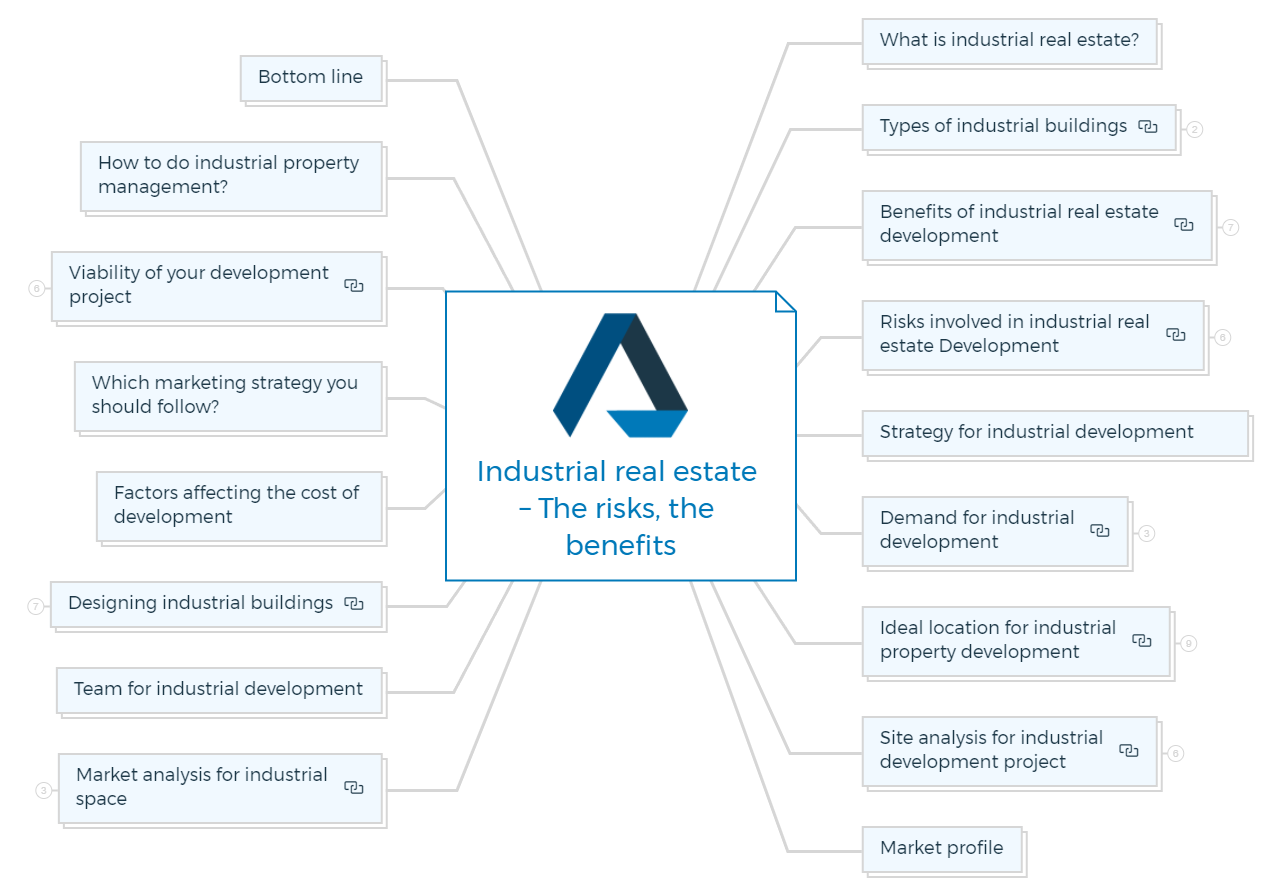
What is industrial real estate?
Industrial real estate is a type of property that is used for manufacturing and storage purposes. The properties are typically large in size and have open spaces to accommodate machinery and products. They also usually have loading docks and other features that are necessary for shipping and receiving goods.
The industrial real estate market has been growing rapidly in recent years as more businesses have been moving their operations out of the city center. This is due to a number of factors, including high rents, increased traffic congestion, and the need for more space. The demand for industrial space is likely to continue to grow in the years ahead as the economy continues to recover.
Types of industrial buildings
Industrial developments are classified as "commercial," but their role demand less sophistication than retail real estate such as malls, offices, etc. They may follow different development principles at times.
Industrial property is made up mostly of various-sized factories and warehouses, and it is divided into the following categories:
- Only one occupant/operation
- Factories/warehouses with strata titles
- Industrial parks
The zoning of industrial structures is divided into two categories:

Industrial 1
Includes work with dangerous materials, manufacturing, and specific applications.
Industrial 2
Warehouses and light manufacturing.
Most industrial structures are simple in design and are not architectural wonders. Large expanses are required, and the building is repetitious and as simple as possible for cost reasons.
Industrial property investments yield a greater rental return, although it depends on the business's health and the building's location. Tenants tend to be more stable and, as a result, take out longer leases due to the significant capital cost and investment required by most tenants to build up an internal plant in industries.
Benefits of industrial real estate development
Industrial real estate development can be profitable from an investment standpoint for the following reasons.
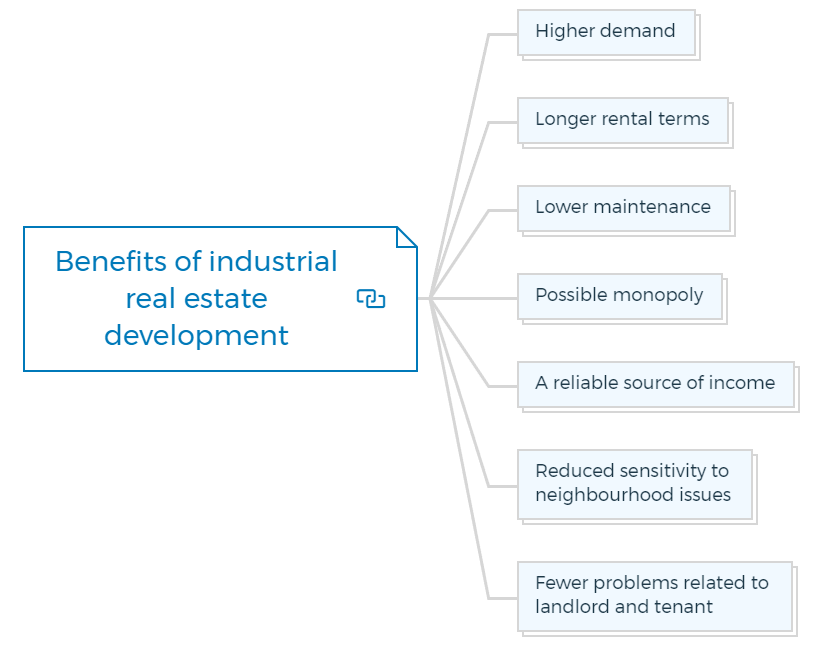
Higher demand
As institutional investors, government bodies, wholesalers and so on diversify their portfolios and increase exposure to the industrial sector, demand for industrial development is growing.
Longer rental terms
Industrial leases generally last three to ten years, although they can go up to 25 years, whereas residential leases last a year. As a result, these properties are more likely to provide consistent revenue over time.
Lower maintenance
Industrial properties do not require as much maintenance as other types of properties. Most leases are triple net, which means the renter is responsible for all upkeep.
On the other hand, more extended lease periods mean that an industrial property owner won't have to renovate as often because tenant turnover is lower.
Possible monopoly
Industrial land is often designed and zoned inside a specific location. If no more land is available for industrial growth, it usually results in a pricing monopoly.
A reliable source of income
Suppose development is designed, built, and rented to suit a prime tenant. In that case, it is done mainly on the assumption that a long-term lease would be signed, providing the investor with a reliable source of revenue for a reasonable period.
Reduced sensitivity to neighbourhood issues
Industrial land is typically allocated early in the planning process as a more effective urban structure plan. When establishing these zones, city planners frequently examine whether or not future adjacent neighbours may cause problems.
Fewer problems related to landlord and tenant
Compared to other real estate types, most industrial enterprises take good care in their operations and have fewer problems with their tenants.
Risks involved in industrial real estate Development
The following are the risks of developing and investing in industrial development.

Significant capital investment is required
Even though industrial properties cost less per square meter to build than other buildings, they are much bigger on the inside and have long roof spans, so they require more capital.
Less escalation potential
Because most leases are long-term, the escalation terms are often fixed and not based on the CPI, so they do not allow for escalation to be adjusted if inflation rises.
Technological advancements
Industrial buildings are at risk of becoming obsolete as manufacturing and assembly technology evolves at a rapid pace to increase production.
Increased government regulation exposure
Because of the large number of people who live in industrial buildings (mainly if they are utilized as processing plants), the construction of these structures may be subject to a lot of government restrictions and inspections.
More sophisticated tenants
Tenants in these buildings are typically well-established firms with lots of lease negotiation experience.
Problems with custom construction
In some cases, a developer has to build a property to meet the specific needs of a tenant, only to find out when the lease is up that it doesn't fit the general market.
Strategy for industrial development
The plan for an industrial project, like other advancements, should be devised to maximize market potential while minimizing development costs. This is true whether the developer plans to sell the finished project or keep it as a long-term investment.
Many developers, especially those who have secured a long-term lease with a reputable corporate tenant, would fall into the latter category. A developer may offer smaller industrial units to owner-operators and investors if the intended project is a group of smaller industrial units aimed at the small business sector.
Alternatively, the developer could sell a percentage of the units to improve their equity and leverage position while keeping the rest as a long-term investment.
Demand for industrial development
Employment patterns mainly determine industrial building demand in the most likely industries to use such structures. It will also be influenced by the individual space requirements of those industries' employees.
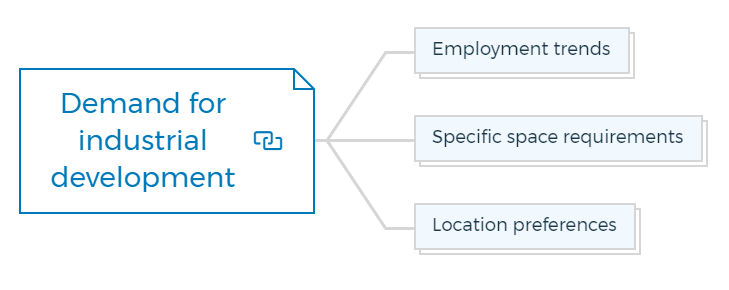
Employment trends
Various variables influence business success, including national and local economics and demographics. However, these factors do not always have the same impact on employment in the industrial sector.
Work in the shipping and cargo industry, for example, is less affected by demographic shifts than employment in the manufacturing and retail sectors.
As a result, a detailed analysis of jobs in a particular industry in a specific area determines the demand for industrial space.
Specific space requirements
Specific space needs differ depending on the industry. The area required per employee in the apparel business, for example, is smaller than that needed in industrial sectors. It is because a clothes manufacturer requires a lot of labour, whereas building products require more machinery and less work.
A precise assessment of individual staff space demands is necessary to assess the market.
Location preferences
Services, transportation, raw material availability, and favourable labour conditions all play a role in determining where certain enterprises will locate.
For example, resource businesses like coal must be located near mining areas, yet the motor manufacturing industry must be near skilled labour and complementing component makers.
Ideal location for industrial property development
When choosing a location, industrial developers consider labour, materials, power, transportation, local government policy, and local operating costs. However, industrial hubs are generally market-driven; therefore, location decisions may be influenced by transport, prestige, and possibilities for related industries.
You should consider the following elements while determining the best location for developing industrial structures.
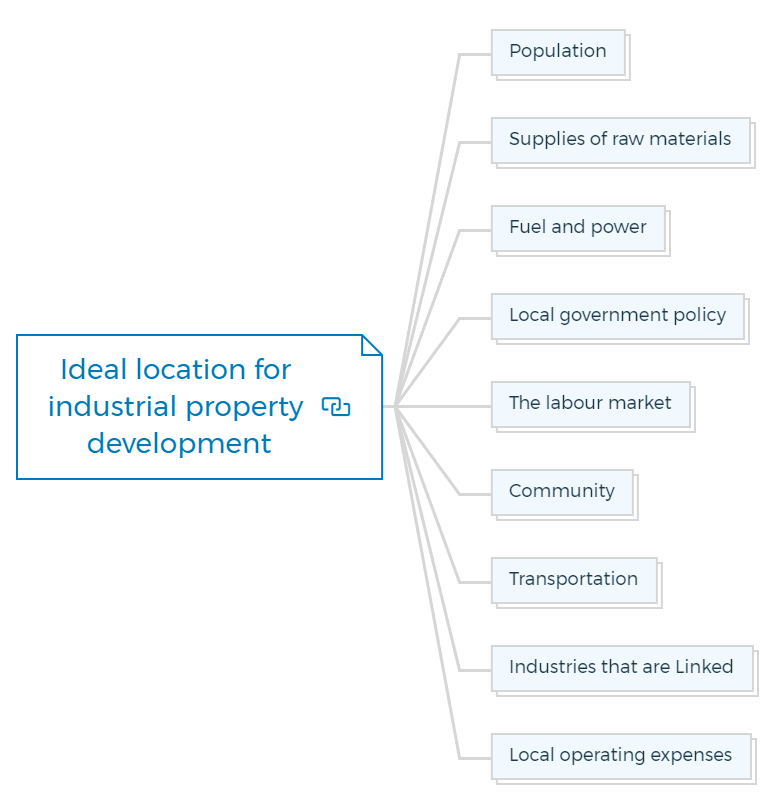
Population
Preference should be given to an area with one million or more population and the potential for significant population and economic growth in this development category.
However, some industrial ventures can succeed in locations with a smaller population, especially if the area possesses the qualities indicated below.
Supplies of raw materials
The availability of raw materials or additional value-added services for an industrial manufacturer could be a crucial deciding factor in establishing their business.
Fuel and power
A manufacturer sees local government or firms' rates and possible concessions for bulk electrical power or fuel as a significant benefit.
Local government policy
Determine the local government's policies regarding tax breaks and economic incentives.
The labour market
Developers should thoroughly examine the local labour market, including the availability of trained labour and costs such as wages—review labour legislation, union dominance, and productivity output.
Community
The local community in some locations may protest the presence of industry and exert pressure against it.
Transportation
Ensure that the site is served by an existing (or projected) highway. Examine the distance to airports, ports, and railway stations as well.
Industries that are linked
Determine the industries that may be relocating to the area and those already there and have plans to expand.
Local operating expenses
Compare and contrast the water, sewerage, waste disposal, energy, transportation, and other related expenses in different areas.
Site analysis for industrial development project
Along with the development's location, you should thoroughly examine the following site criteria -
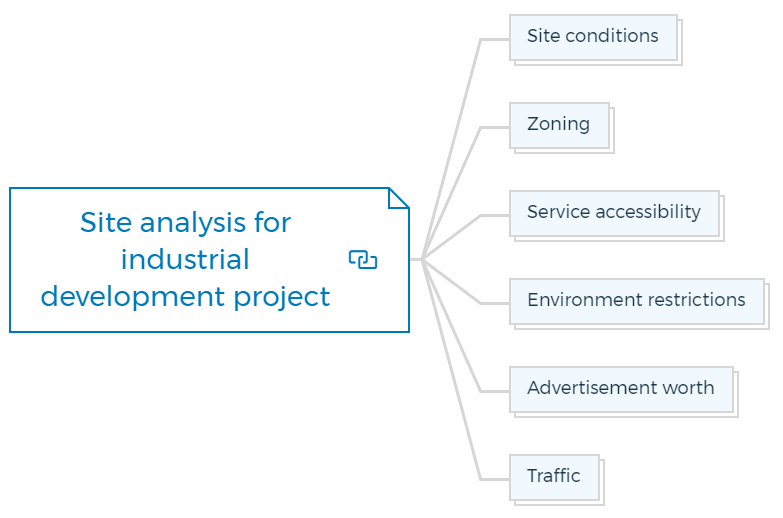
Site conditions
Examine soil samples to determine the soil-bearing capacity. You might find an old landfill or ex-refuse site on certain industrial-zoned land.
Examine the land's shape, terrain, and contours; industrial structures necessitate broad, flat areas, which decreases or eliminates the cost of any land excavation or filling, as well as the necessity for retaining walls.
Zoning
Ascertain that the proposed industrial building's planned or intended use complies with the local structure plan, zoning, easements, and any other title constraints.
Service accessibility
Check where the nearest service connections are located. Long distances to water, power, and sewerage could significantly increase the construction budget. Examine whether the current services can meet the user's needs.
Environment restrictions
For manufacturing or processing plants, ensure that the structures and their use comply with strict environmental regulations enforced by local, state, and federal agencies.
Advertisement worth
If the site gives advertising exposure that can be seen from a major highway or arterial road, it is a plus for the developer.
Traffic
Examine if the current road system can comfortably accommodate the movement of huge vehicles and future traffic loads.
By understanding a thorough site acquisition process, you can identify how risky or safe a project is.
Get The Edge Now!
Discover the transformative power of our FREE EDGE platform and
unlock a world of opportunities at no cost!

Your Real Estate Toolkit Awaits!
Free eBooks, Courses & Feasibility Suite Trial—Join Today!
✓ Unlimited FREE Trial: Experience the full power of our Feasibility Suite with hands-on demos
—explore without limits, no time pressure & without commitment or credit card!
✓ Learn from Success: Dive into real-life case studies for practical insights.
✓ Engage, Inquire, and Innovate: Ask questions, request features, and engage in lively discussions.
✓ Showcase Your Projects and Gain Insights: Share your projects and get personalised feedback.
✓ Free Resources Galore: Access a treasure trove of free resources,
eBooks & courses to keep you informed.
✓ Exclusive Training: Enjoy members-only training to sharpen your skills.
Market profile
Individuals or businesses in need of industrial facilities fit the following market profiles:
- Industrial facilities are typically planned and created for national manufacturing enterprises or significant corporations for their unique use. The corporation either builds the facilities or leases them for an extended period.
- National distributors, such as substantial supermarket chains or department shops, require many warehouse and office spaces strategically positioned near sound transportation systems and possibly market visibility.
- Private and institutional investors are the two types of investors. Institutional investors will seek more significant buildings with critical and stable tenants, while smaller private investors will be looking for smaller strata-type developments.
- Small business owners require smaller industrial units for manufacturing or storage. These companies would search for a strata complex to purchase or rent.
Market analysis for industrial space
To analyze the market, one must first comprehend the market need for industrial space, which may be divided into two categories: 'generated demand' and 'replacement demand.'
New companies intending to locate in a new area or existing companies wishing to expand their operations develop generated demand, which accounts for most of the market.
Established businesses want to replace obsolete facilities with better operational planning, such as better architectural design, better parking, more excellent trucking manoeuvrability, and reduced operating expenses.
Consider the below factors while conducting a market analysis.
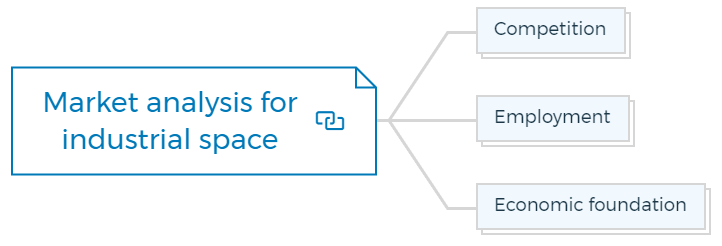
Competition
A competitive analysis should provide crucial foundations for the marketing strategy, such as competitive sale and leasing policies, the range of items on the market, and the level of supplementary services supplied to prospective tenants.
Employment
An employment study can influence the demand for industrial growth by determining what changes in employment have occurred in the last 10 years and the predicted trends for the next ten.
Economic foundation
An economic basis analysis is essential for assessing the local community's economic base regarding current economic trends, possibilities, and shortcomings. This data will aid in identifying the types of industrial customers who will be the most likely suppliers of industrial space demand.
Team for industrial development
The development team performs most efficiently in large-scale industrial development projects when members continuously coordinate their functions.
For industrial real estate development, you will need the following team members.
- Architect
- Development Manager
- Quantity Surveyor
- Structural Engineer
- Civil Engineer
- Electrical Engineer
- Mechanical Engineer
Specific areas of the development may require specialist involvement and the primary members of the team. Industrial consultants, fire consultants, public relations consultants, geotechnical engineers, environmental scientists, and traffic engineers are examples of such specialists.
Designing industrial buildings
The design of industrial buildings or structures will vary and be influenced by several factors. The operator's specific requirements, site conditions, and, in the case of strata units, the intended market are examples of these conditions.
Structural engineers design most industrial buildings because the structure aims to give big open spaces. Because most industrial buildings store enormous pieces of machinery or the tenant requires the building's layout to be changed to fit into the area, vast open spaces with fewer structural columns are ideal because they allow flexibility and ease of movement.
You may consult an architect or building designer for aesthetic reasons and when more intricate planning is necessary.
In any case, you should consider the following design factors:
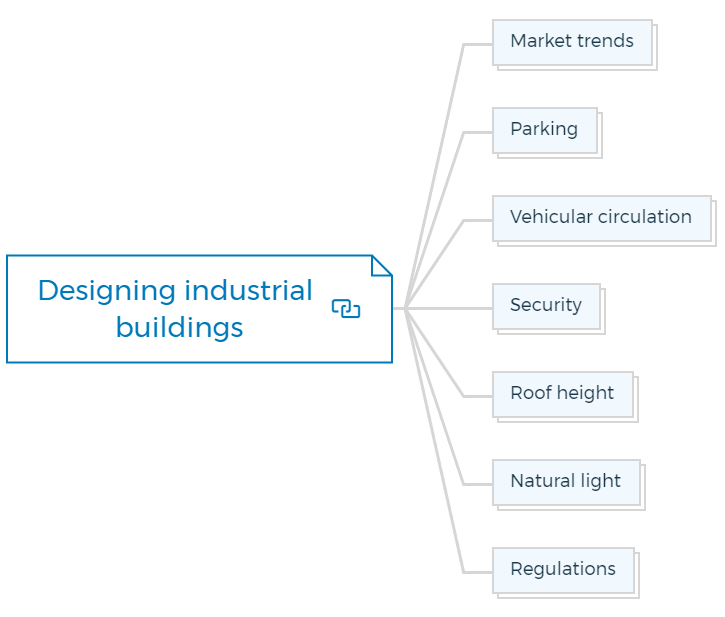
Market trends
Before drafting the plan, assess current trends and technology.
Parking
Offer enough space for heavy trucks and vehicles to move around.
Vehicular circulation
Offer enough space for heavy trucks and vehicles to move around.
Security
Add fences and gates to provide utmost security.
Roof height
Should be generous (gantries may be required to move heavy equipment or material overhead).
Natural light
Ideally from the south (there is less sunlight and glare from the south than the north, east or west, so windows facing south provide more consistent lighting)
Regulations
Check all statutes and building codes before proceeding.
Factors affecting the cost of development?
The development cost estimate is a critical component of a project's feasibility. The physical character of the site, the lot size compared to the area, and the location and availability of municipal facilities are all factors that influence industrial development costs.
The following items are usually included in the total costs:
- Land cost: Ensure that the residual factors are considered.
- Bulk services: Ensure that the bulk services are adequate.
- Connection fees for services and utilities
- The price of building
- Costs for development and building plans
- Fees for project management
- Short building time and early occupation mean less interest loss and lower holding costs.
- Cost of escalation: Depending on the size of the project, try to negotiate a fixed contract.
- Fees for professionals
- Insurance policies
- Levies: Transportation and other statutory levies.
- External development costs, such as road widening
- Exchange of information
- Bank fees
Check out the property development feasibility suite for becoming a geek in this process.
Which marketing strategy you should follow?
The marketing strategy for industrial developments should be the same for office and other commercial buildings: get significant tenants. It makes the project an attractive investment and the project secure in the eyes of institutional funders.
Construction on a single-operator industrial facility should not begin until a tenant has been found and all lease obligations met. The risks are too significant, and if the tenant fails to meet specific promises and conditions, the developer could be left with an unfinished structure.
You can take a certain level of risk in a minor stratum development. Still, it should be conditional on the developer conducting all essential market research and being satisfied that the marketing programme will acquire the necessary tenants or buyers.
The marketing programme or strategy needs to be aligned with the developer's aims and the findings of the marketing analysis.
Viability of your development project
A feasibility assessment, as well as a sensitivity analysis, should be conducted for all developments. Keep the following criteria in mind.

Construction and design
Consultation with a specialized industrial designer is essential. Such an expert should have a thorough understanding of advanced construction processes, resulting in the most floor area for the lowest total construction cost, increasing the development's feasibility.
Outgoings
Even if they are passed on to the tenant, you should consider all expenses. Some tenants agree to a lease where the landlord pays a portion of the operational costs.
Returns
Examine the acceptable returns on such developments in the area you plan to build. If you are providing space for a single, stable national tenant, you may be willing to accept a lower initial return if you consider the long-term benefit.
Phasing
It makes good sense to consider phasing in proportion to demand depending on the scale of the development. For example, if your proposed development can handle 10,000 square metres of the building, but the current demand is only for 5,000 square metres, you may construct the 5,000 square metres in Phase One and the balance in Phase Two as demand grows.
Tenants
The advantage of investing in industrial property is that it will likely require fewer tenants to fill it, resulting in fewer issues for the landlord. Any investor who is successful in securing a well-known national tenant can be assured that their cash flow will be constant for the duration of the lease, which is an ideal circumstance.
When an industrial building is custom-built to a tenant's specifications, it's critical to gather some background information on the tenant from other people in the same field and inquire about their position and reputation.
Leases
Industrial property leases, like commercial and office leases, come into two categories: the first is where the tenant is a small business, the lease is landlord-oriented, and the second is where larger companies negotiate the lease in their favour.
How to do industrial property management?
A property manager may be necessary depending on the size and complexity of the development. If you choose a property manager, make sure they have experience with industrial buildings in terms of management abilities and their network within the industrial community to guarantee they have access to potential tenants.
Bottom line
Industrial real estate development is among the simplest development projects available. Of course, it is reliable on the size of the operation and the associated capital costs.
In most cases, you'll be dealing with fewer tenants and consultants, which will free up more of your time. These renters will also sign a long-term lease, making the package appealing to most investors.
If you're interested in learning more about property development, strategies, and facts, immediately enrol for the best structural property development courses.
FAQs

